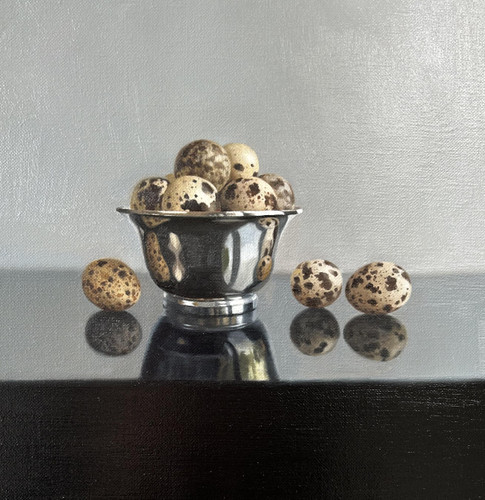The History of Oils - Part One
2nd Dec 2024
By Rupert Maas
This is the first part of an article from the FBA archives written by Rupert Maas in 2009.
The Artist Explorer was generously funded by Foyle Foundation.
Jan van Eyck discovers the secret of oils
Much of the early history of oil painting is about what did not happen in our isolated country. The Renaissance that transformed and humanised painting in Italy in the 1500s did not really happen for us. Science, music and, especially literature, flourished in Britain, but the sensual world of paint remained unexplored.
It was left to the intrepid Dutch to show us the way. And, when they did, it was as much through chemistry as through artistry. They showed the Italians, too. The back and forth of ideas and techniques between Italy and Holland throughout the 15th Century was complex. However, painting in oils was originally a Dutch breakthrough, led by Jan van Eyck. He painted The Arnolfini Marriage in 1434 and was a pioneer in the alchemy of paint, as well as one of the first artists to sign their work.
In earlier times, artists were limited to water-based paints that dried too quickly. If they were working large on a wall, they couldn’t stop for a break and they had to work bit by bit. If they were working on wood, the colour was flat and lifeless.
Until van Eyck’s time, such oils as there were dried too slowly, if at all, and were murky and yellow. Van Eyck mixed raw pigment powder with organic oils, boiling calcined bones in linseed oil of the flax plant. This was a breakthrough because it finally perfected a stable mixture that ‘dried’ in a useful time. (Actually, strictly speaking, oil paint does not dry, or evaporate, like watercolour, rather it oxidises and ‘sets’).
The magic of the new medium
Once this formula had been achieved, a painter could, for the first time, wake up in the morning and build on what he had accomplished the day before. And what a vast array of new effects were now available to him! A Whole new library of colour, texture, light and space.
Oil releases the properties of the colours and makes them transparent or opaque at will, so they can then be mixed or overlaid in limitless combinations. The human eye is capable of differentiating between tens of millions of colours, but until The Arnolfini Marriage no painter had ever been able to exploit this amazing ability. This rich new paint quality must have seemed at the time like “reality held in a glass paperweight”.
Other artists develop the formula
Van Eyck kept his formula secret until just before he died. Next, Antonello da Messina added lead oxide to improve the consistency and drying time, and he is credited with having introduced the new process to Renaissance Italy. A little later that century Leonardo da Vinci improved the clarity by adding beeswax at lower temperatures, and later still Rubens used turpentine spirit as a thinner.
The more oil in the paint the ‘fatter’ it is and the longer it takes to dry. The more turps, the ‘leaner’ it is said to be, and it dries quicker. Painters knew they should paint fat over lean, or they risked cracking, with undried paint trapped under dried paint.
New techniques, new ideas
The new techniques coincided with new ideas in Italy. By the 1500s brilliant pageants of Saints, ordered, static and bejewelled, had given way to Man, naked and alone in huge landscapes, or men contending with one another in powerful dramas.
Perspective - that astonishing trick of 3D recession into mathematically projected space - was introduced.
The new possibilities of form and colour, embodied in Michelangelo the designer and Titian the colourist, echoed down through the ages through similar comparisons between Ingres and Delacroix, then Picasso and Matisse.
Early oils in Northern Europe
Meanwhile, in the colder, Protestant North, Man was depicted clothed and surrounded by his fellows. Although he had been released from being cooped up indoors, it was sometimes into a threatening and difficult environment.
In Pieter Brueghel’s Dark Day, there is no story told, and yet the scene, a hard existence in a vast landscape in February, is exactly described. It is an early instance of landscape for its own sake, where mood overcomes narrative, not to be seen in English art until the 18th Century.
© Rupert Mass 2009
Image by Linda Alexander, 'Quail's Eggs'
